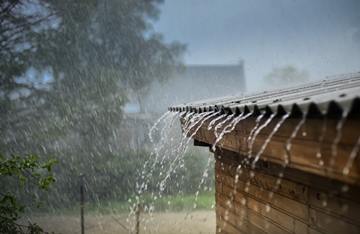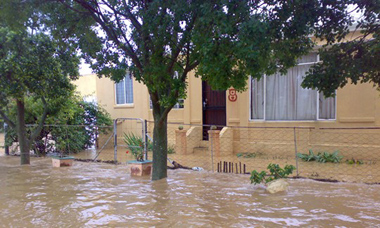How to prepare for a flood
There's often no way to prevent a flood, but there are many ways to keep safe and ensure that you and your family are safe. Floods are usually caused by storms that bring heavy rain and can cause serious damage once the water accumulates on land and enters homes and other buildings. People living in low-lying areas are most affected. Other possible causes include:
- poor drainage,

- seeping; caused by water rising through cracks,
- rise of water levels in seas, rivers, canals and dams, and
- leaking in old or poorly built structures.
Seawater floods are caused by ocean current surging together with strong winds that blow across the sea. This makes huge waves that flow onto land and flood seaside areas. This scenario is most common on the southern coast.
Be prepared
Get to know your community's emergency plans, warning signals, evacuation routes and locations of emergency shelters.
During severe storms, you can listen to your local radio station or use social media, for warnings about possible floods and determine how it affects traffic in your neighbourhood. Here’s what you need to do:
Before a flood
- Have a first aid kit and include all necessary medication.
- Save emergency numbers on your cellphone.
-
Contact your insurance company to ensure that natural disasters are covered.
-
Teach your children to memorise your phone number in the correct order.
-
Keep all your personal documents, credit cards and medical aid details in a waterproof bag.
-
Pack dry clothing to keep warm.
-
Have an emergency whistle to signal for help.
-
Pack non-perishable foods, candles, water and matches.
-
Safeguard your home by fixing cracks, pipes and clearing gutters.
-
Raise your appliances off the ground.
-
Seal your walls and open spaces, by adding other materials to keep the water out.
-
Have a torch, battery radio and spare batteries.
-
Switch off all electrical appliances.
-
Tie down all moveable objects outside of your home.
-
Keep animals indoors with you.
-
Sandbags are a simple, but effective way to prevent or reduce flood water damage. It can act as a barrier to divert moving water around, instead of through your house.
 During a flood
During a flood
-
Monitor the news using your radio or social media.
-
Avoid flooded roads, especially where water appears to be rushing.
-
Travel to high-lying areas, particularly areas advised by emergency services.
-
Avoid low-lying areas and areas near rivers and dams.
-
Trust emergency authorities and evacuate if instructed to do so.
-
Take your pets with you.
-
Leave your car if it can't move.
-
Stay off bridges. Fast-moving water can wash bridges away without warning.
-
If your vehicle is trapped in fast-moving water, then stay inside the vehicle. If water is rising inside the vehicle, then seek refuge on the roof.
-
If trapped in a building, go to its highest level. Don’t climb into a closed attic as you may become trapped by rising floodwater. Go on the roof only if necessary and then signal for help.
After a flood
- Call your insurance company to find out about claiming for damages.
- Don’t use any electrical appliances until an electrician has checked your home.
- Avoid using water as it may be contaminated, you should contact your local municipality to confirm water quality.
Be extra vigilant and careful
-
Never try to walk, swim, drive or play in floodwater, it could be contaminated by sewage.
-
Be aware of electricity and animals in floodwater when cleaning up after a flood.
-
Be careful in the dark. Evacuating in the evening is very dangerous, as flood hazards may be difficult to see.
Have an emergency plan
Don't be caught off-guard. Discuss an emergency plan with your family and work out an escape route in case there's a flood near or in your home and make sure you know the emergency numbers you might need.
Emergency numbers
Dial 112 from any cellphone, or 10177 from a landline in case of an emergency.
You can also contact your district disaster management centre for more assistance.
| District | Contact person | Telephone | Address |
| National | Dr Mmaphaka Tau | 012 848 4602 |
Riverside Office Park, Letaba House, 2nd Floor, 1303 Heuwel Avenue, Centurion. |
| Western Cape | Colin Deiner | 021 937 6301 |
EMS Building, Tygerberg Hospital premises, Francie Van Zijl Drive, Parow. |
| City of Cape Town | 080 911 4357 | ||
| Cape Winelands | Shaun Minnies | 021 888 5847/0861 265 263 | c/o Bird and Langenhoven Streets, Stellenbosch |
| Central Karoo | Hein Rust | 023 449 1000 / 023 414 4467 | N1 North Weighbridge, Beaufort West. |
| Eden | Gerhard Otto | 044 803 1300 | 54 York Street, George. |
| Overberg | Reinhard Geldenhuys | 028 425 1157/1690 | 26 Long Street, Bredasdorp. |
| West Coast | Suretha Visser | 022 433 8700 | 17 Station Street, Mooreesburg. |
Get the support you need
You can find help and support from the South African Weather Services, Eskom and South African Police Services before and after a flood has occurred.


